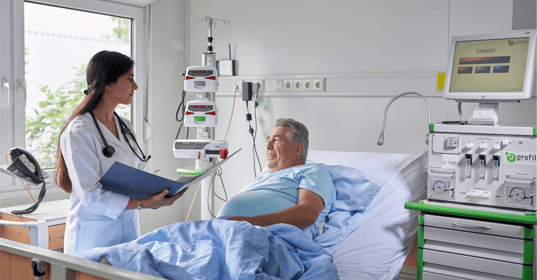PubMed Central, the free full-text archive of biomedical and life sciences journal literature at the U.S. National Institutes of Health’s National Library of Medicine (NIH/NLM) lists 163 publications on biosimilar insulins during the last 5 years (43 during the last year) [1], reflecting a growing interest in this topic.
Profil has performed more than 30 clinical trials to demonstrate pharmacokinetic (PK) and pharmacodynamic (PD) bioequivalence (BE) of novel biosimilar insulin preparations. 15 of these BE trials were carried out in the last 5 years. Almost 20% of all published BE studies in that time frame were performed at Profil - the most recent one has been published this year [2], two others were published in 2021 [3, 4].
The following table provides an overview about the most important criteria with respect to study design, study population and endpoints of these three bioequivalence trials with novel biosimilar insulins performed at Profil and briefly summarizes the key results.
Please also refer to our online seminar on Biosimilar Insulins.
In case you have any additional questions related to clinical trials on biosimilar insulins or other biosimilar compounds in the field of diabetes as well as on further Profil publications on biosimilar insulins, we will be happy to receive your email or call.

|
|
Plum-Mörschel L et al 2022 (2)
|
Hövelmann U et al 2021 (3) |
Kapitza C et al |
|
Biosimilar insulin |
Biocon‘s biosimilar Insulin 70/30 |
MYL-1601D |
SAR341402 (insulin aspart) Mix 70/30 |
|
Type of insulin |
Premixed insulin (70% intermediate-acting isophane insulin, 30% short-acting human soluble insulin) |
Rapid-acting human insulin analogue
|
Premixed insulin (70% intermediate-acting isophane insulin, 30% short-acting human soluble insulin) |
|
Reference insulin |
HUMULIN® 70/30
|
US and European insulin aspart
|
Cohort 1: |
|
Insulin dose
|
A single s.c. dose of 0.4 IU/kg of each insulin
|
A single s.c. dose of 0.2 U/kg of each insulin
|
Cohort 1 and 2: SAR341402 Mix 70/30 and SAR341402 insulin aspart solution (Cohort 2) |
|
Study design
|
Phase 1, (1:1) randomized, double-blind, two-treatment, two-sequence, crossover, 24-hour automated euglycemic glucose clamp trial |
Phase 1, (1:1:1:1:1:1) randomized, double-blind, three-treatment, three-period, crossover, 12-hour automated euglycemic glucose clamp trial |
A randomized, double-blind, single-dose, four-treatment (Cohort 1 = 3 treatments/ |
|
Wash-out period between dosings |
5-7 days |
12-16 days after first dosing, 3-14 days after second dosing |
Cohort 1 and 2: 5-18 days |
|
Clamp duration |
24 hours |
12 hours |
24 hours |
|
Clamp level |
81 mg/dL |
81 mg/dL |
100 mg/dL |
|
Clamp device |
ClampArt, Profil, Neuss, Germany |
ClampArt, Profil, Neuss, Germany |
ClampArt, Profil, Neuss, Germany |
|
Study population
|
Healthy male and postmenopausal female subjects aged 18-55 yrs (both inclusive), BMI 18.5-29 kg/m² (both inclusive) |
Male and female subjects with FPG*** ≤100 mg/dL, aged 18-65 yrs (both inclusive), BMI 18.5-29 kg/m² (both inclusive) |
Cohort 1 and 2: Male and female subjects with type 1 diabetes, 18-64 yrs (both inclusive), BMI 18-30 kg/m² (both inclusive), HbA1c ≤9% |
|
Results |
|||
|
Subjects randomized (n)
|
78 |
72 (71 exposed to study drug) |
Total: 52 Cohort 1: 36 Cohort 2: 16 |
|
Completers (n)
|
74 |
66 |
Total: 48 Cohort 1: 34 Cohort 2: 14 |
|
Primary PK endpoints: |
|||
|
AUCIns.0-xxh
|
AUCIns.0-24h (h*ng/L) |
AUCINS.0-12h (h*pg/mL): |
Cohort 1:
|
|
CIns.max |
CIns.max (ng/L) |
CIns.max (pg/mL): |
CIns.max (pg/mL) |
|
Primary PD endpoints: |
|||
|
AUCGIR.0-xxh
|
AUCGIR.0-24h (mg/kg) |
AUCGIR0-last (mg/kg): |
Secondary PD endpoints: Cohort 1: AUCGIR0-24h (mg/kg)Cohort 2: AUCGIR0-4h (mg/kg)and AUCGIR4-12h (mg/kg) |
|
GIRmax |
GIRmax (mg/kg/min) |
GIRmax (mg/kg/min) |
GIRmax (mg/kg/min) |
|
Clamp performance/Clamp quality
|
Mean precision variability: < 5% for both treatments.
Mean deviation from clamp target (mg/dL):
|
Mean precision (CV, %): 5.47 (Mylan-1601D);
Mean deviation from clamp target (mg/dL):
|
Mean precision (CV%): 4.65 (SAR-Asp-Mix); 4.55 (NN-Mix US); 4.39 (NN-Mix EU) Cohort 2: 4.30 (SAR-Asp-Mix); 5.49 (SAR-Asp)
|
|
Safety |
Both insulins generally well tolerated. No clinically significant changes in vital signs, physical examinations or ECGs. No SAEs**, deaths or discontinuations for safety/tolerability reasons. |
Both insulins generally well tolerated. No significant safety issues. No clinically significant changes in vital signs, physical examinations or ECGs. No SAEs**, deaths or discontinuations for safety/tolerability reasons. |
Both insulins generally well tolerated. No significant safety issues. |
|
Equivalence shown? |
Yes,
|
Yes,
|
Cohort 1: (SAR-Asp-Mix vs NN-Mix US and EU): Yes, for primary PK and secondary PD endpoints Cohort 2: |
*TEAEs: Tretment Emergent Adverse Events
**SAEs: Serious Adverse Events
Read more about our expertise in testing medical technology: Insulin pump development and design, artificial pancreas study and the AP@home project, glucose monitoring.




